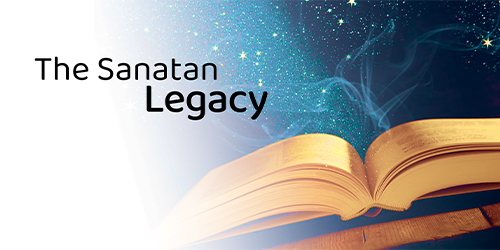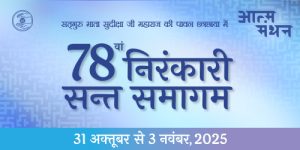We can all be born into families and be part of institutions with great legacies, but is this enough? One must ask, are all legacies worth upholding? The word Sanatan means Eternal, that is everlasting and timeless. And, when we talk about legacies, the oldest legacy passed on to humanity, through ancient times by great saints and sages, is the legacy of God-Knowledge -The Brahmgyan. Brahmgyan is the divine nectar that all holy scriptures expounded for the benefit of mankind. When I think of the Sanatan Legacy, only one thing comes to my mind—Brahmgyan, for it is eternal and worth upholding.
I consider my elder generations to be truly blessed and feel grateful and indebted to them since they got enlightened by this Brahmgyan and they decided to help me attain it too by introducing me to the Sant Nirankari Mission. Today, the Sant Nirankari Mission is upholding this Sanatan Legacy of God-Knowledge and is helping mankind to see the ultimate truth—to know that there is nothing but Brahm(an), the Formless One. As it is also stated in the famous first verse of the Isha Upanishad –
Purnamadah Purnamidam, Purnat Purnamudachyate
Purnasya Purnamadaya, Purnameva Vashishyate
It is through Brahmgyan, that one gets the divine vision to see god and is able to achieve a state of transcendence where one is content with the realization of the self. This reminds me of an instance when Satguru Mata Sudiksha Ji once quoted Brihadaranyaka Upanishad – “Aham Brahmasmi” in her discourse which propounds that each soul is divine and a part of supreme consciousness. As far as the literal translation goes, it means “I am God”. But it truly holds the meaning when uttered by a realized soul. To unravel the true meaning, under the guidance of the Satguru, one must engage in deeper introspection and ask these three questions-
- What is this ‘I’?
- What is Brahm(an)?
- How are they one?
Let’s tackle the first question of ‘what this ‘I’ is’. We usually believe that this ‘I’ is my body and, with it, the senses and then the brain that processes whatever the senses perceive. We think our identity is this body. So, if I am the body, then there is the mind too that can have layers to this identity because, in the world, I support different roles like a parent, student, employee, business owner, etc. This mind is our ability to reason, intuition, perception, will (desire), memory, and imagination that takes us beyond the five senses. However, all of this relies on one thing – the body’s existence. However, under the influence of Maya (Material World) and Ignorance, even a small event or substance can alter how our mind may reason, desire, perceive, remember, or even imagine.
In the Bhagavad Gita (Chapter 2, Verse 16), Sri Krishna states: ‘The asat (unreal) has no beingness, and sat (real) is that which never ceases to be. The essence of both is held by the tattvadarsis—the ‘Realized Ones.’
Our body and mind have a limited lifetime and upon death, they cease to exist. This means the body and the mind cannot be my real identity. Therefore, going back to understanding what this ‘I’ is, it is clear that, according to the Bhagavad Gita, it cannot be the body and mind. The body decays and dies, and the senses slowly lose vitality as we age. The mind slows down; sometimes, memory fails us; sometimes, we cannot reason well; sometimes, our emotions weigh heavy. The ‘I’ has to be something more than all of this.
Sri Krishna guides us in Bhagavad Gita (Ch.2 V.18) that ‘The Indweller is eternal, indestructible and immeasurable. However, the bodies in which he dwells are said to have an end.’ The true ‘I’ is that essence that does not change, that cannot be destroyed, is vaster than this body and mind, and most of all is beyond time itself. This ‘I’ is truly the Atma(n) – the individual consciousness housed in the body and mind, and Brahmgyan, through its neti-neti (not this, not this) process, shows us that we are not the elements at all because we are aware of them as objects to this individual consciousness.
The second question is, what is Brahm(an)?Once I know what this ‘I’ is, more importantly, I want to know what this consciousness is. Is it truly just individual to me? Is this Consciousness a part of a Whole Consciousness? The Upanishads have helped us understand the nature of Consciousness.
In the Katha Upanishad (Part 1, Ch. 2, V.18), It is written,
‘The all-knowing Self was never born, Nor will it die. Beyond cause and effect, this Self is eternal and immutable. When the body dies, the Self does not die.’
Among many qualities of Brahm(an), one is that it is not born. Therefore, there is no beginning. It never dies and, hence, is eternal. It sprang from no object because it is the Eternal Subject (Knower of its own Self). Most importantly, and this is a line that the Bhagavad Gita also echoes, this Consciousness does not die even when the body dies. Nothing happens to this Consciousness.
In the Prashna Upanishad (Question 4. V. 9 – 11), it is stated that this Brahm within us can activate the senses to taste, touch, smell, etc. It is the one that thinks and acts. The most important aspect is that this Brahm is Formless, without any shadow or impurity. Remember, shadows appear due to objects, and the Formless is not an object. It is Pure because it doesn’t mix with anything. Know that Brahman is all there is.
This beautifully leads us to answer the third question of how the ‘I’ and ‘Brahman’ are one and the same. The Shwetashvatar Upaniṣhad (6.11) states –
Eko devaḥ sarvabhuteṣhu guḍhaḥ
sarvavyapi sarvabhutantaratma
Which means “God is one. He resides in the hearts of all living beings. He is omnipresent. He is the Supreme Soul of all souls”. The only way to understand how this is possible, we have to go back to the Katha Upanishad (Part 2. Ch.2 V.6-10). Here, the realized saints guide us in understanding that we must first restrain our senses. If we let the senses do what they want, we will forever identify with the body. That person will never be able to satiate the hunger of desires. We must go beyond the mind, which processes all the senses’ perceptions. Then, we must transcend the intellect that discerns between right and wrong, good and evil, and all other pairs of opposites; it is in the intellect that viveka (discernment) sharpens to help us observe Reality as it is. Going beyond that, we have the ego, which believes it is everything; even the world is theirs, and everything in the world is theirs. Yet, beyond this, ‘I’ is Brahman, the only one present, and no second (object) can say that it exists. It is nirguna, beyond attributes. With attributes, there are boundaries, but attributeless means no limitation; it is boundless. Only when we fully surrender and have all the five senses, mind, and intellect stilled can we attain jivan-mukti (liberation while alive).
Now, is the saying ‘Aham Brahmasmi’ an arrogant statement? Absolutely not. But it is a beautiful realization from which we can never escape. It is an Eternal, Formless Awareness that has immersed itself into all yet is distinct from All.
The legacy that began with the holy scriptures and now Satguru Mata Sudiksha Ji Maharaj continues this legacy by bestowing this Brahmgyan and helping the seekers to become realized beings. Such realized beings can say ‘Aham Brahmasmi’ with unflinching faith in the formless God.
Intro – It is through Brahmgyan, that one gets the divine vision to see god and is able to achieve a state of transcendence where one is content with the realization of the self.
Blurb 1 – In the Bhagavad Gita (Chapter 2, Verse 16), Sri Krishna states: ‘The asat (unreal) has no beingness, and sat (real) is that which never ceases to be. The essence of both is held by the tattvadarsis—the ‘Realized Ones.’ Blurb 2 – Which means “God is one. He resides in the hearts of all living beings. He is omnipresent. He is the Supreme Soul of all souls.
By Rahul Singh from Atlanta -USA









